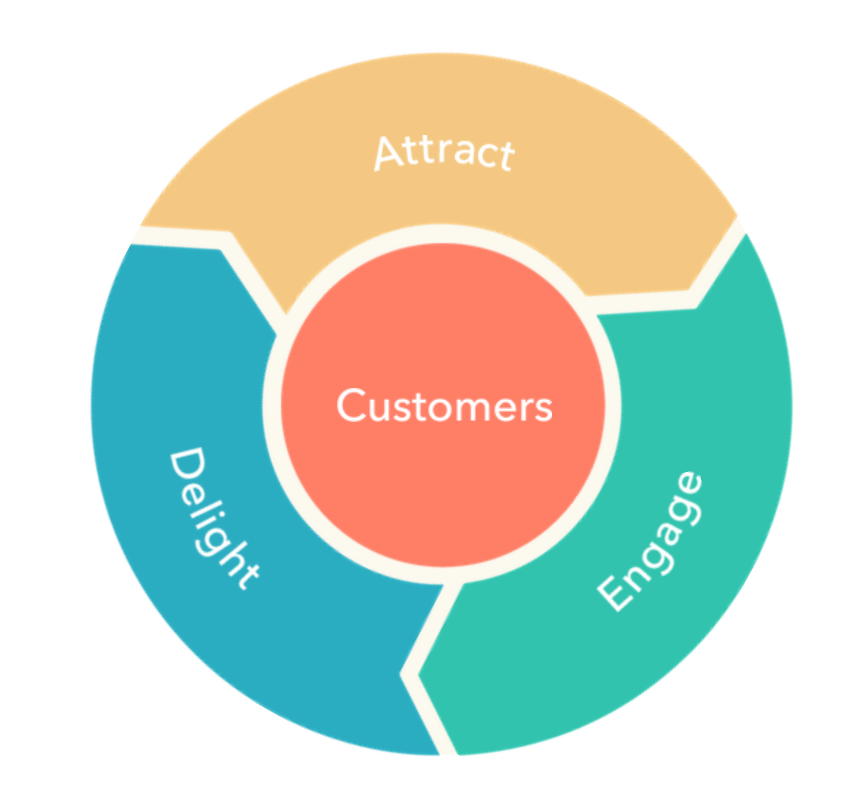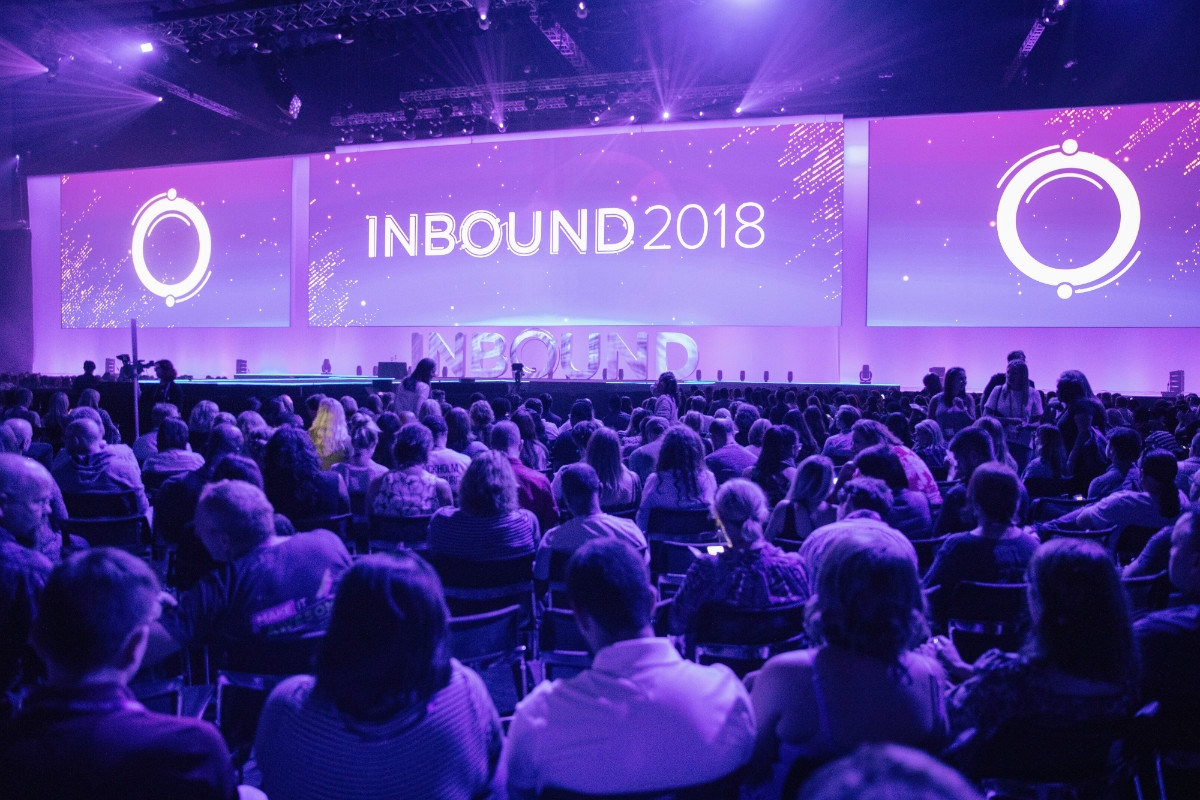In the early days of demand generation, the traditional funnel excelled at helping businesses streamline their processes to move prospective customers from the top of the funnel to closed business. However, there has been a movement within the B2B marketplace toward breaking down the traditional sales funnel that the industry has come to adopt. You can see that in examples such as the #FlipMyFunnel movement and other analysts’ interpretations of the customer journey.
The goal for these renovations to the traditional funnel is to move away from focusing on growing how you go to market, and instead, focusing on your customers’ experience and using it to help companies better attract, engage and delight prospects. At HubSpot’s annual INBOUND conference this year, the company unveiled a new Flywheel framework, a look at the customer journey designed to focus heavily on the customer experience and having that be the main driver of growth for your business.
This concept was discussed at length during the event, where more than 24,000 registrants gathered to learn about how they must pivot their business strategies to meet the demand of evolved buying behaviors that rely more on trust and word-of-mouth than consistent marketing and sales touches.
During his keynote presentation, HubSpot Founder and CEO Brian Halligan discussed how there is a shift currently happening in the marketplace that will greatly change the way buyers buy and companies sell.
“We’re in a big era shift, similar to the shift I saw when we first started HubSpot,” said Halligan. “The Internet has really shifted under our feet. We’ve moved from an era where the best product always wins, to where the best customer experience usually always wins.”
The Flywheel framework aims to address this push towards focusing on the customer experience by breaking the customer journey into four parts:
- Attract: Educate visitors with content and eliminate any barriers that may hinder their ability to gather the information they need;
- Engage: Build relationships by engaging with buyers on their terms;
- Delight: Shift resources to help tie your business’ success to your customers’ success; and
- Customers: Placed at the center, businesses will focus on removing friction to help their customers succeed and fuel growth for both themselves and their customers.
“We’re moving from an era where we created a funnel and filled it with friction to an era where — if you want to win and have a delightful customer experience — a flywheel can ease that friction,” said Halligan.

“If B2B wants to get ahead of the game, they are going to have to get rid of all the friction in their business to better attract, engage and delight customers,” said Halligan. “It used to be what you sold that mattered, but now it’s how you sell. There is a big opportunity for those to take advantage of this. Three tips: become more self-service, become more customer efficient and decrease handoffs.”
The unveiling of HubSpot’s Flywheel framework aligns with the company’s recent Enterprise Growth Suite announcements, which are designed to reduce the friction customers face when scaling their tech stack to meet the growing needs of their company.
Overcoming The Imagination Gap
During a morning keynote session, Beth Comstock, former Vice Chair at GE, discussed how the evolution of technology has turned employees into machines instead of the humans they need to be to create meaningful customer relationships.
“Things are changing 100x faster than ever; hyper connectivity is creating multitudinous change and seemingly disparate acts are turning into patterns that multiply complexity,” said Comstock. “We’re not ready to handle emergent change. For decades, we insisted our businesses and employees work like efficient, fine-tuned machines long before AI.”
This “machine mind” has created an imagination gap in communities, where business opportunities ultimately never meet fruition. “We’re losing the ability to think ahead, as well as the courage to find our ways in and out of those eventualities,” she added.
To overcome it, Comstock stated that marketing and salespeople must give themselves permission to change the way that their company does business. “If there’s one thing you can take away today, it’s this: change happens when you give yourself permission to imagine a better future, and then you make it happen.”
Cracking The ‘Customer Code’ For Better Buying Experiences
In another keynote, HubSpot Founder and CTO Dharmesh Shah shared his insights on how the company has seen its culture impact the way that its business is now engaging with current and prospective customers. He noted that culture shifts in business are not only making employees and customers happy, but also fueling more growth than solely product innovation.
“You don’t need to make your product 10x better, you need to make your experience 10x lighter,” said Shah. “Also, improving your experience 10x is much easier than improving product 10x.”
Shah listed out the company’s “Customer Code,” a framework designed to help companies become more customer focused and meet customer needs:
- Earn their attention, don’t steal it;
- Treat them like a person, not a persona;
- Solve for their success, not your company’s systems;
- Use their data, but don’t abuse it;
- Ask for customer feedback and act on it;
- Own your screw ups;
- Help customers help you by letting them help themselves;
- Customers don’t mind paying, but do mind being played;
- Don’t block the exit. (i.e. don’t make it difficult for customers to end the relationship); and
- Do the right thing, even when it’s hard.
Traversing The Buying Journey Cyclone With Mapped-Out Tactics, Metrics
While the HubSpot Flywheel framework seems simple, a case can still be made that all the known stages of the buying journey found in traditional funnels can be easily filled into it. In a session with Eric Keiles, CMO of Square 2 Marketing, he broke down the Flywheel even further into eight stages:
- Pre-awareness;
- Awareness;
- Education;
- Consideration;
- Evaluation;
- Rationalization;
- Decision; and
- Ongoing delivery.
“We all know that the buyer’s journey is no longer linear, it’s circular in a big cyclone where everyone is congregating these crazy influences,” said Keiles. “Build your own tactics map that actually relates to where they are in the journey. Your job is to help them jump from cyclone to cyclone as easily as possible.”
According to Keiles, it is vital for businesses to map out the tactics that are used for each of these stages, as well as the metrics that help measure each stage to gain a clearer picture of how you can refine your efforts and promote further growth.
“I want you to think of two states: your current state — how many people are converting — and the future state — where you want to be,” said Keiles. “What do our metrics have to look like to be where we want to go? Ultimately, the gap you uncover indicates the amount of work and effort you’ll have to put in to get to where you want to be.”
Bridging Tech-Caused Disconnections By Leveraging Insights To Fuel Relationships
Kevin Cochrane, CMO of SAP Customer Experience, presented a session on how the growth of technology in the marketplace leads to more disconnection than the desired connection that it was intended to create.
“We live in a time of disconnection. The more technology we have, the more disconnected we’ve become,” said Cochrane. “We’re living in a time where attention spans are so short that they are more than likely to move on if it doesn’t pique their interest.”
To combat this, Cochrane reiterated that building relationships with customers is vital to ongoing growth in the industry. “The centerpiece for success is the relationships that we as brands need to have with our customers,” he added.
While businesses can gather more data than ever before, Cochrane said that vendors will have to prove to their prospective customers that they can provide instantaneous value from the data they have collected.
“Consumers are going to demand to not manipulate them with that data, but provide value from having that data,” said Cochrane. “Customers want brands to connect them to the communities they want to be a part of. It’s about connecting communities; it’s the era of having online conversation.”
Removing Friction And Building Trust By Being Sensical And Real
Brian Fanzo, Founder of iSocialFanz, reiterated during his session that businesses that are creating great customer experiences are not being innovative in the eyes of their customers. “In today’s generation, for example, buyers look at Uber as the option that makes the most sense, not as the most innovative,” he said.
Making your business more sensical also positions businesses to empower their employees to bring their personality into the content and tactics used to engage with prospects digitally. Ultimately, the goal is to build trust and shrink the gap between customers and the business.
“We’re living in an on-demand world — we want in when we want it,” said Fanzo. “How do we connect with people? Every business is in the business of trust, but how do I make trust happen? How do we shrink the distance online?”
Fanzo argues that to build trust and connect with their audience, companies must make themselves personal and relatable.
“For us as marketers, in the world of fake news, inundation and lack of trust, I will argue that people will buy from people they relate to,” he added.
Fanzo suggested that brand presence in the digital world should match the personalities of the people operating that brand. He added that being able to relate with a brand online helps shrink that trust gap and, ultimately, positions businesses to create more meaningful engagement and relationships.
He concluded, “If you’re not sharing that same conversation online, you’ll never have the same conversion compared to face-to-face.”







